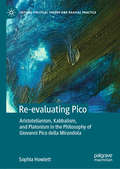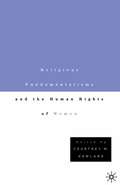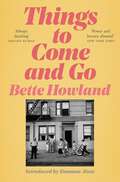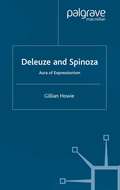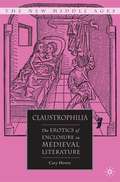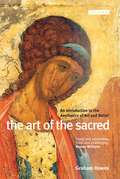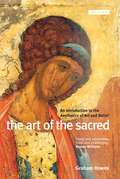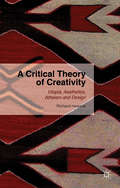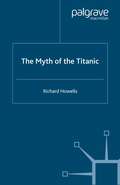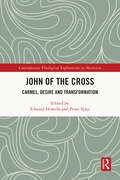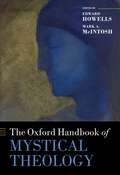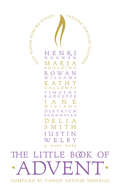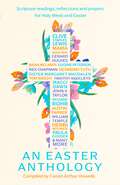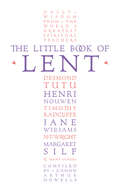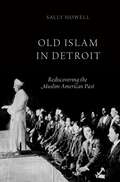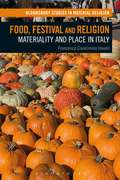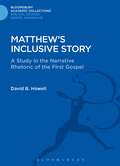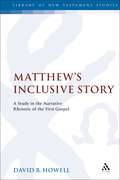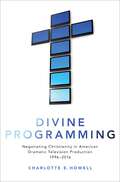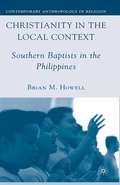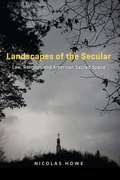- Table View
- List View
Re-evaluating Pico: Aristotelianism, Kabbalism, and Platonism in the Philosophy of Giovanni Pico della Mirandola (Critical Political Theory and Radical Practice)
by Sophia HowlettThis book offers a re-evaluation of Giovanni Pico della Mirandola, the prominent Italian Renaissance philosopher and prince of Concord. It argues that Pico is part of a history of attempted concordance between philosophy and theology, reason and faith. His contribution is a syncretist theological philosophy based on Christianity, Platonism, Aristotelianism and Jewish Kabbalism. After an introduction, Chapter 2 discusses Pico’s career, his power-relations and his work, Chapters 3 and 4 place his three pillars of Platonism, Aristotelianism and Kabbalism in their historical context, examines shared histories, and introduces the scholars around Pico who contributed so much in each of these traditions (introducing, for example, Christian Kabbalism), including exploring Pico's complex relationship with Marsilio Ficino. Chapter 5 examines the problems of concordance within Pico’s cosmology and metaphysics, including the question of God and the role of the Intellect. Chapter 6 describes Pico’s ‘exceptionalist’ version of the mystical ascent as an individualized ascetic experience. Pico eschews the contemporary desire to use a renewed christian thinking or christian-classical metaphysics to change the world (towards a Golden Age or a 'second coming') to present a personal path to God, with no return to the world.
Religious Fundamentalisms and the Human Rights of Women
by Courtney W. HowlandDialogue on the conflict between religious fundamentalism and women's rights is often stymied by an 'all or nothing' approach: fundamentalists claim of absolute religious freedom, while some feminists dismiss religion entirely as being so imbued with patriarchy as to be eternally opposed to women's rights. This ignores, though, the experiences of religious women who suffer under fundamentalism and fight to resist it, perceiving themselves to be at once religious and feminist. In Religious Fundamentalisms and the Human Rights of Women , Howland provides a forum for these different scholars, both religious and nonreligious, to meet and seek common ground in their fight against fundamentalism. Through an examination of international human rights, national law, grass roots activism, and theology, this volume explores the acute problems that contemporary fundamentalist movements pose for women's equality and liberty rights.
Things to Come and Go
by Bette Howland'Stunning power and beauty abound in this book.' - The New York Times'Howland recalls the short-story writer Lucia Berlin' - Harper's Magazine'Honest, acerbic, alert, and always dazzling.' - Amitava Kumar, author of Immigrant, MontanaThings to Come and Go showcases the incomparable talent of Bette Howland in three novellas of stunning power, beauty, and sustaining humour.‘Birds of a Feather’ is a daughter’s story of her extended, first-generation family, the ‘big, brassy yak-yakking Abarbanels’. Esti, a merciless, astute observer, recalls growing up amid (the confusions and difficulties of) their history, quarrels, judgements, and noisy love, and the sense of estrangement and inescapable bonds of blood.The clamour of the city, both its threat and its possibility, are just outside the door in ‘The Old Wheeze’, as a single mother in her twenties returns to her sunless apartment after a date at the ballet. Shifting between four viewpoints – the young woman, the older professor who took her out, her son, and her son’s babysitter – the story masterfully captures the impossibility of liberating ourselves from the self.In ‘The Life You Gave Me’, a woman at the midpoint of life is called to her father’s sickbed. A lament for all that is forever unsaid and unsayable, the story is ‘an anguished meditation on growing up, growing old and being left behind, a complaint against time.’ (The New York Times)First published in 1984, Things to Come and Go, Bette Howland’s final book, is a collection of haunting urgency about arrivals and departures, and the private, insoluble dramas in the lives of three women. This edition features an introduction by Rumaan Alam, bestselling author of Leave the World Behind.
Deleuze and Spinoza: Aura of Expressionism
by G. HowieExpressionism, Deleuze's philosophical commentary on Spinoza, is a critically important work because its conclusions provide the foundations for Deleuze's later metaphysical speculations on the nature of power, the body, difference and singularities. Deleuze and Spinoza is the first book to examine Deleuze's philosophical assessment of Spinoza and appraise his arguments concerning the Absolute, the philosophy of mind, epistemology and moral and political philosophy. The author respects and disagrees with Deleuze the philosopher and suggests that his arguments not only lead to eliminativism and an Hobbesian politics but that they also cast a mystifying spell.
Claustrophilia: The Erotics of Enclosure in Medieval Literature (The New Middle Ages)
by C. HowieThrough extended readings of English, French, and Italian writers of the Thirteenth and Fourteenth centuries, Claustrophilia shows that medieval enclosures actually make room for desires and communities that a poetics of pure openness would exclude.
The Art of the Sacred: An Introduction to the Aesthetics of Art and Belief
by Graham HowesThe field of 'art and religion' is fast becoming one of the most dynamic areas of religious studies. Uniquely, The Art of the Sacred explores the relationship between religion and the visual arts - and vice versa - within Christianity and other major religious traditions. It identifies and describes the main historical, theological, sociological and aesthetic dimensions of 'religious' art, with particular attention to 'popular' as well as 'high' culture, and within societies of the developing world. It also attempts to locate, and predict, the forms and functions of such art in a changing contemporary context of globalization, modernity, secularism and fundamentalism. The author concentrates on four chief dimensions where religious art and religious belief converge: the iconographic; the didactic; the institutional; and the aesthetic. This clear, well-organised and imaginative treatment of the subject should prove especially attractive to students of religion and visual culture, as well as to artists and art historians.
The Art of the Sacred: An Introduction to the Aesthetics of Art and Belief
by Graham HowesThe field of 'art and religion' is fast becoming one of the most dynamic areas of religious studies. Uniquely, "The Art of the Sacred" explores the relationship between religion and the visual arts - and vice versa - within Christianity and other major religious traditions. It identifies and describes the main historical, theological, sociological and aesthetic dimensions of 'religious' art, with particular attention to 'popular' as well as 'high' culture, and within societies of the developing world. It also attempts to locate, and predict, the forms and functions of such art in a changing contemporary context of obligation, modernity, secularism and fundamentalism. The author concentrates on four chief dimensions where religious art and religious belief converge: the iconographic; the didactic; the institutional; and the aesthetic. This clear, well-organised and imaginative treatment of the subject should prove especially attractive to students of religion and visual culture, as well as to artists and art historians.
A Critical Theory of Creativity: Utopia, Aesthetics, Atheism and Design
by R. HowellsA Critical Theory of Creativity argues that a Utopian drive is aesthetically encoded within the language of form. But coupled with this opportunity comes a very human obligation which cannot be delegated to God, to nature or to market forces. As Ernst Bloch declared: 'Life has been put into our hands.'
The Myth of the Titanic
by R. HowellsThe first critical analysis of the Titanic as modern myth, this book focuses on the second of the two Titanics . The first was the physical Titanic , the rusting remains of which can still be found twelve thousand feet below the north Atlantic. The second is the mythical Titanic which emerged just as its tangible predecessor slipped from view on 15 April 1912. It is the second of the two Titanics which remains the more interesting and which continues to carry cultural resonances today. The Myth of the Titanic begins with the launching of the 'unsinkable ship' and ends with the outbreak of the 'war to end all wars'. It provides an insight into the particular culture of late-Edwardian Britain and beyond this draws far greater conclusions about the complex relationship between myth, history, popular culture and society as a whole.
John of the Cross: Carmel, Desire and Transformation (Contemporary Theological Explorations in Mysticism)
by Edward Howells Peter TylerThis book explores the life and teaching of John of the Cross, the Spanish mystic who remains a major source of Western thought on spirituality, theology and mysticism. Leading academics discuss the importance and legacy of John from historical, theological, philosophical, pastoral, ecumenical, psychological and literary perspectives. The book focuses on his place in Carmel, his understanding of desire, and the role of transformation in his theology. Approaching John in the context of the late medieval mystical tradition, it offers a timely re-evaluation of his work and a significant reassessment of his relevance in the context of current debates.
The Oxford Handbook of Mystical Theology (Oxford Handbooks)
by Edward Howells Mark A. McIntoshThe Oxford Handbook of Mystical Theology provides a guide to the mystical element of Christianity as a theological phenomenon. It differs not only from psychological and anthropological studies of mysticism, but from other theological studies, such as more practical or pastorally-oriented works that examine the patterns of spiritual progress and offer counsel for deeper understanding and spiritual development. It also differs from more explicitly historical studies tracing the theological and philosophical contexts and ideas of various key figures and schools, as well as from literary studies of the linguistic tropes and expressive forms in mystical texts. None of these perspectives is absent, but the method here is more deliberately theological, working from within the fundamental interests of Christian mystical writers to the articulation of those interests in distinctively theological forms, in order, finally, to permit a critical theological engagement with them for today. Divided into four parts, the first section introduces the approach to mystical theology and offers a historical overview. Part two attends to the concrete context of sources and practices of mystical theology. Part three moves to the fundamental conceptualities of mystical thought. The final section ends with the central contributions of mystical teaching to theology and metaphysics. Students and scholars with a variety of interests will find different pathways through the Handbook.
The Little Book of Advent: Daily Wisdom From The World's Greatest Spiritual Teachers
by Canon Arthur HowellsThe Little Book of Advent is an indispensable collection of readings from some of the most celebrated modern-day spiritual writers, with passages specially selected for each day of Advent.
An Easter Anthology: Scripture readings, reflections and prayers for Holy Week and Easter
by Arthur HowellsA beautiful gift anthology for the season of Easter with material from Tom Wright, Timothy Radcliffe, Basil Hume, Rowan Williams, Brian McLaren, Paula Gooder, Henri Nouwen, Desmond Tutu, Maria Boulding. Compiled by Canon Arthur Howells, a retired canon in the Church in Wales, this delightful collection is the perfect gift for the Lenten season.
The Little Book of Lent: Daily Reflections From The World's Greatest Spiritual Writers
by Arthur HowellsAn inspirational source of encouragement for Lent.
Old Islam in Detroit: Rediscovering the Muslim American Past
by Sally HowellAcross North America, Islam is portrayed as a religion of immigrants, converts, and cultural outsiders. Yet Muslims have been part of American society for much longer than most people realize. This book documents the history of Islam in Detroit, a city that is home to several of the nation's oldest, most diverse Muslim communities. In the early 1900s, there were thousands of Muslims in Detroit. Most came from Eastern Europe, the Ottoman Empire, and British India. In 1921, they built the nation's first mosque in Highland Park. By the 1930s, new Islam-oriented social movements were taking root among African Americans in Detroit. By the 1950s, Albanians, Arabs, African Americans, and South Asians all had mosques and religious associations in the city, and they were confident that Islam could be, and had already become, an American religion. When immigration laws were liberalized in 1965, new immigrants and new African American converts rapidly became the majority of U.S. Muslims. For them, Detroit's old Muslims and their mosques seemed oddly Americanized, even unorthodox. Old Islam in Detroit explores the rise of Detroit's earliest Muslim communities. It documents the culture wars and doctrinal debates that ensued as these populations confronted Muslim newcomers who did not understand their manner of worship or the American identities they had created. Looking closely at this historical encounter, Old Islam in Detroit provides a new interpretation of the possibilities and limits of Muslim incorporation in American life. It shows how Islam has become American in the past and how the anxieties many new Muslim Americans and non-Muslims feel about the place of Islam in American society today are not inevitable, but are part of a dynamic process of political and religious change that is still unfolding.
Old Islam in Detroit: Rediscovering the Muslim American Past
by Sally HowellAcross North America, Islam is portrayed as a religion of immigrants, converts, and cultural outsiders. Yet Muslims have been part of American society for much longer than most people realize. This book documents the history of Islam in Detroit, a city that is home to several of the nation's oldest, most diverse Muslim communities. In the early 1900s, there were thousands of Muslims in Detroit. Most came from Eastern Europe, the Ottoman Empire, and British India. In 1921, they built the nation's first mosque in Highland Park. By the 1930s, new Islam-oriented social movements were taking root among African Americans in Detroit. By the 1950s, Albanians, Arabs, African Americans, and South Asians all had mosques and religious associations in the city, and they were confident that Islam could be, and had already become, an American religion. When immigration laws were liberalized in 1965, new immigrants and new African American converts rapidly became the majority of U.S. Muslims. For them, Detroit's old Muslims and their mosques seemed oddly Americanized, even unorthodox. Old Islam in Detroit explores the rise of Detroit's earliest Muslim communities. It documents the culture wars and doctrinal debates that ensued as these populations confronted Muslim newcomers who did not understand their manner of worship or the American identities they had created. Looking closely at this historical encounter, Old Islam in Detroit provides a new interpretation of the possibilities and limits of Muslim incorporation in American life. It shows how Islam has become American in the past and how the anxieties many new Muslim Americans and non-Muslims feel about the place of Islam in American society today are not inevitable, but are part of a dynamic process of political and religious change that is still unfolding.
Food, Festival and Religion: Materiality and Place in Italy (Bloomsbury Studies in Material Religion)
by Francesca Ciancimino HowellFood, Festival and Religion explores how communities in northern Italy find a restorative sense of place through foodways, costuming and other forms of materiality. Festivals examined by the author vary geographically from the northern rural corners of Italy to the fashionable heart of urban Milan. The origins of these lived religious events range from Christian to vernacular Italian witchcraft and contemporary Paganism, which is rapidly growing in Italy. Francesca Ciancimino Howell demonstrates that during ritualized occasions the sacred is located within the mundane. She argues that communal feasting, pilgrimage, rituals and costumed events can represent forms of lived religious materiality. Building on the work of scholars including Foucault, Grimes and Ingold, Howell offers a theoretical “Scale of Engagement” which further tests the interfaces between and among the materialities of place, food, ritual and festivals and provides a widely-applicable model for analyzing grassroots events and community initiatives.Through extensive ethnographic research and fieldwork data, this book demonstrates that popular Italian festivals can be ritualized, liminal spaces, contributing greatly to the fields of religious, performance and ritual studies.
Food, Festival and Religion: Materiality and Place in Italy (Bloomsbury Studies in Material Religion)
by Francesca Ciancimino HowellFood, Festival and Religion explores how communities in northern Italy find a restorative sense of place through foodways, costuming and other forms of materiality. Festivals examined by the author vary geographically from the northern rural corners of Italy to the fashionable heart of urban Milan. The origins of these lived religious events range from Christian to vernacular Italian witchcraft and contemporary Paganism, which is rapidly growing in Italy. Francesca Ciancimino Howell demonstrates that during ritualized occasions the sacred is located within the mundane. She argues that communal feasting, pilgrimage, rituals and costumed events can represent forms of lived religious materiality. Building on the work of scholars including Foucault, Grimes and Ingold, Howell offers a theoretical “Scale of Engagement” which further tests the interfaces between and among the materialities of place, food, ritual and festivals and provides a widely-applicable model for analyzing grassroots events and community initiatives.Through extensive ethnographic research and fieldwork data, this book demonstrates that popular Italian festivals can be ritualized, liminal spaces, contributing greatly to the fields of religious, performance and ritual studies.
Matthew's Inclusive Story: A Study in the Narrative Rhetoric of the First Gospel (The Library of New Testament Studies)
by David B. HowellMatthew has been described as an 'inclusive story', in which the experiences of the evangelist's post-Easter church are inscribed in the story of Jesus's earthly ministry. This book explores the inclusive nature of the Gospel by means of reader-response literary criticism. Some recent redaction studies of Matthew are reviewed from the perspective of reader-response criticism. Then, in an attempt to understand the interpretative moves readers make, Matthew's story, story-teller and audience are examined.
Matthew's Inclusive Story: A Study in the Narrative Rhetoric of the First Gospel (The Library of New Testament Studies #42)
by David B. HowellMatthew has been described as an 'inclusive story', in which the experiences of the evangelist's post-Easter church are inscribed in the story of Jesus' earthly ministry. This book explores the inclusive nature of the Gospel by means of reader-response literary criticism. Some recent redaction studies of Matthew are reviewed from the perspective of reader-response criticism. Then, in an attempt to understand the interpretative moves readers make, Matthew's story, story-teller and audience are examined.
Divine Programming: Negotiating Christianity in American Dramatic Television Production 1996-2016
by Charlotte E. HowellFrom the mid-90s to the present, television drama with religious content has come to reflect the growing cultural divide between white middle-America and concentrated urban elites. As author Charlotte E. Howell argues in this book, by 2016, television narratives of white Christianity had become entirely disconnected from the religion they were meant to represent. Programming labeled 'family-friendly' became a euphemism for white, middlebrow America, and developing audience niches became increasingly significant to serial dramatic television. Utilizing original case studies and interviews, Divine Programming investigates the development, writing, producing, marketing, and positioning of key series including 7th Heaven, Friday Night Lights, Rectify, Supernatural, Jane the Virgin, Daredevil, and Preacher. As this book shows, there has historically been a deep ambivalence among television production cultures regarding religion and Christianity more specifically. It illustrates how middle-American television audiences lost significance within the Hollywood television industry and how this in turn has informed and continues to inform television programming on a larger scale. In recent years, upscale audience niches have aligned with the perceived tastes of affluent, educated, multicultural, and-importantly-secular elites. As a result, the televised representation of white Christianity had to be othered, and shifted into the unreality of fantastic genres to appeal to niche audiences. To examine this effect, Howell looks at religious representation through four approaches - establishment, distancing, displacement, and use - and looks at series across a variety of genres and outlets in order to provied varied analyses of each theme.
DIVINE PROGRAMMING C: Negotiating Christianity in American Dramatic Television Production 1996-2016
by Charlotte E. HowellFrom the mid-90s to the present, television drama with religious content has come to reflect the growing cultural divide between white middle-America and concentrated urban elites. As author Charlotte E. Howell argues in this book, by 2016, television narratives of white Christianity had become entirely disconnected from the religion they were meant to represent. Programming labeled 'family-friendly' became a euphemism for white, middlebrow America, and developing audience niches became increasingly significant to serial dramatic television. Utilizing original case studies and interviews, Divine Programming investigates the development, writing, producing, marketing, and positioning of key series including 7th Heaven, Friday Night Lights, Rectify, Supernatural, Jane the Virgin, Daredevil, and Preacher. As this book shows, there has historically been a deep ambivalence among television production cultures regarding religion and Christianity more specifically. It illustrates how middle-American television audiences lost significance within the Hollywood television industry and how this in turn has informed and continues to inform television programming on a larger scale. In recent years, upscale audience niches have aligned with the perceived tastes of affluent, educated, multicultural, and-importantly-secular elites. As a result, the televised representation of white Christianity had to be othered, and shifted into the unreality of fantastic genres to appeal to niche audiences. To examine this effect, Howell looks at religious representation through four approaches - establishment, distancing, displacement, and use - and looks at series across a variety of genres and outlets in order to provied varied analyses of each theme.
Christianity in the Local Context: Southern Baptists in the Philippines (Contemporary Anthropology of Religion)
by B. HowellIn three congregations, representing three distinct social locations, Howell goes beneath the surface to argue that even with these Western forms, these Filipino Baptists are actively constructing themselves and the locality itself in terms of this global faith they have made their own.
Landscapes of the Secular: Law, Religion, and American Sacred Space
by Nicolas Howe“What does it mean to see the American landscape in a secular way?” asks Nicolas Howe at the outset of this innovative, ambitious, and wide-ranging book. It’s a surprising question because of what it implies: we usually aren’t seeing American landscapes through a non-religious lens, but rather as inflected by complicated, little-examined concepts of the sacred. Fusing geography, legal scholarship, and religion in a potent analysis, Howe shows how seemingly routine questions about how to look at a sunrise or a plateau or how to assess what a mountain is both physically and ideologically, lead to complex arguments about the nature of religious experience and its implications for our lives as citizens. In American society—nominally secular but committed to permitting a diversity of religious beliefs and expressions—such questions become all the more fraught and can lead to difficult, often unsatisfying compromises regarding how to interpret and inhabit our public lands and spaces. A serious commitment to secularism, Howe shows, forces us to confront the profound challenges of true religious diversity in ways that often will have their ultimate expression in our built environment. This provocative exploration of some of the fundamental aspects of American life will help us see the land, law, and society anew.
